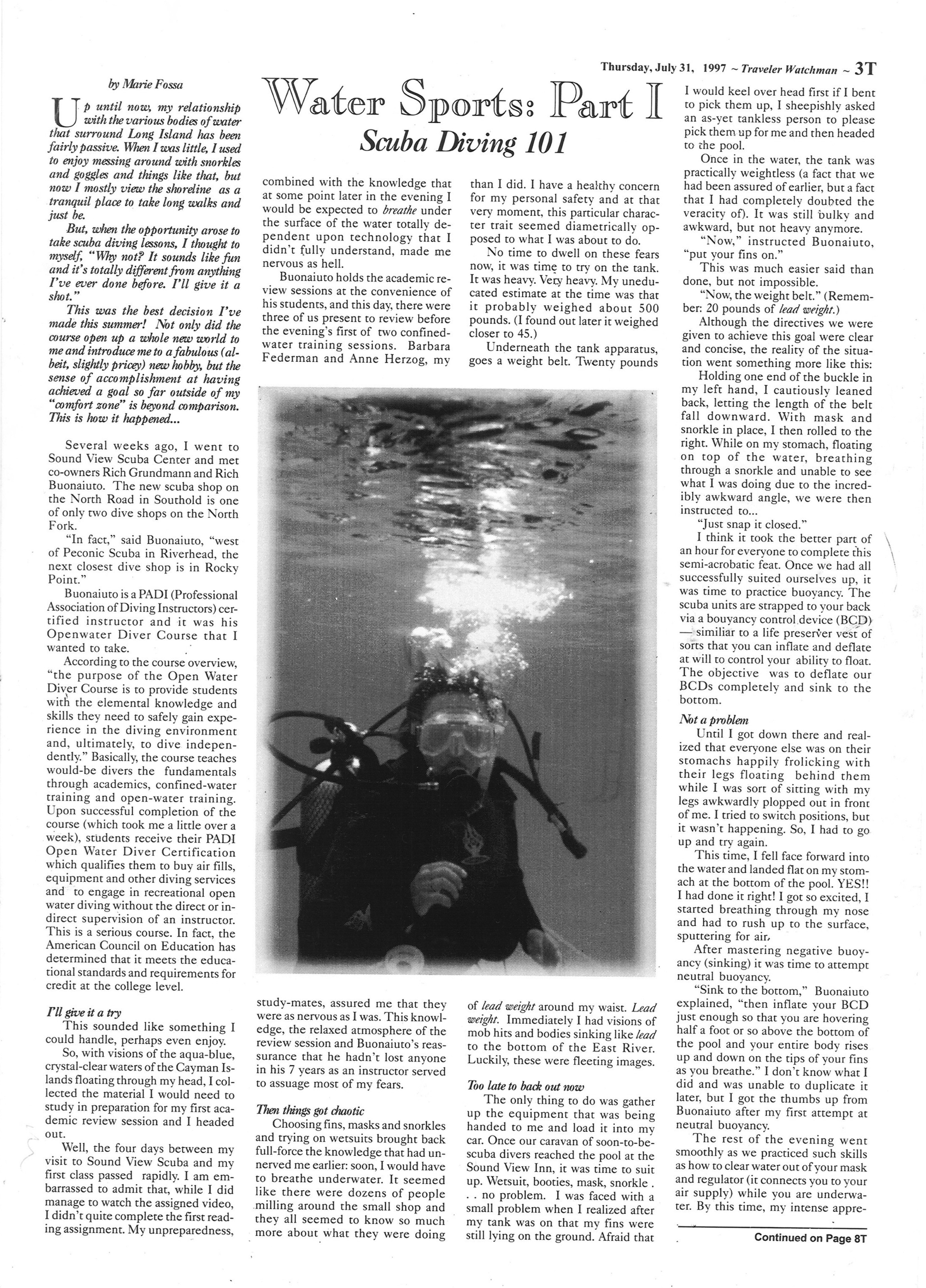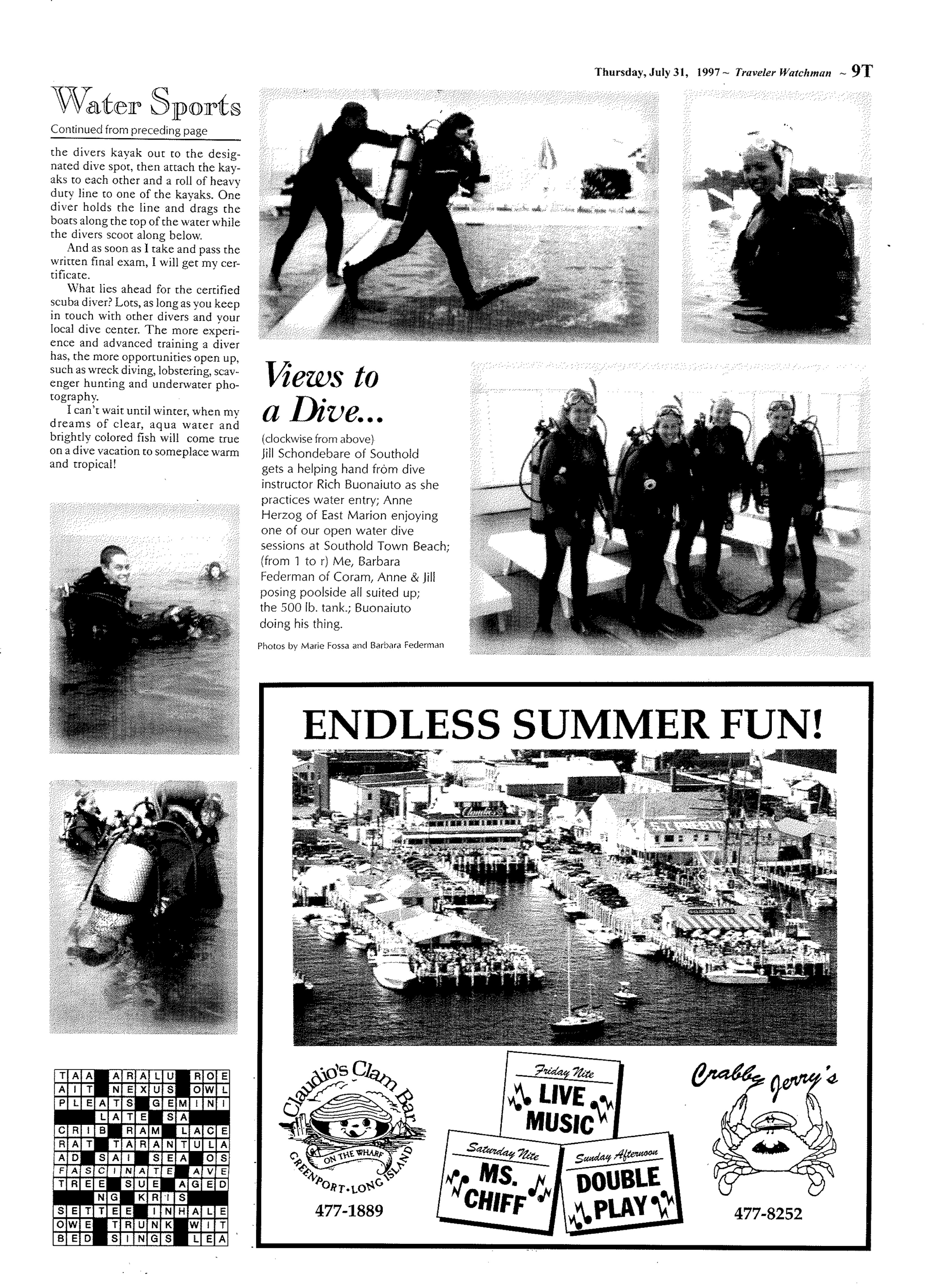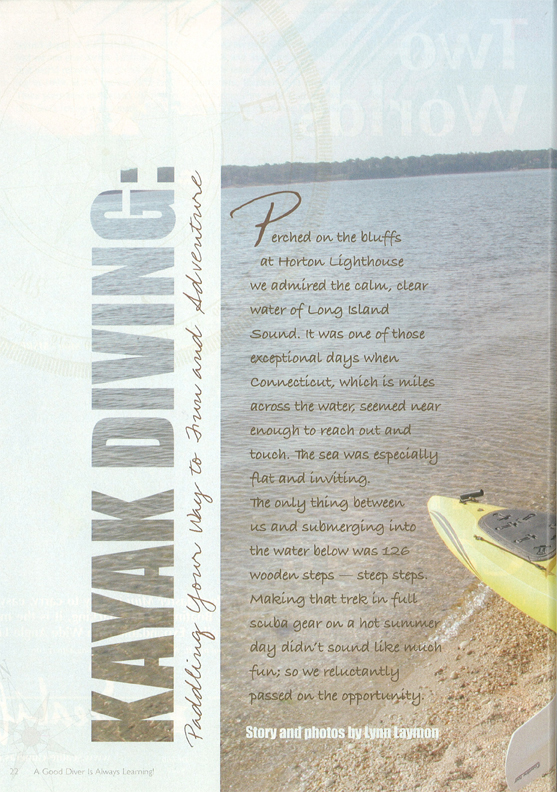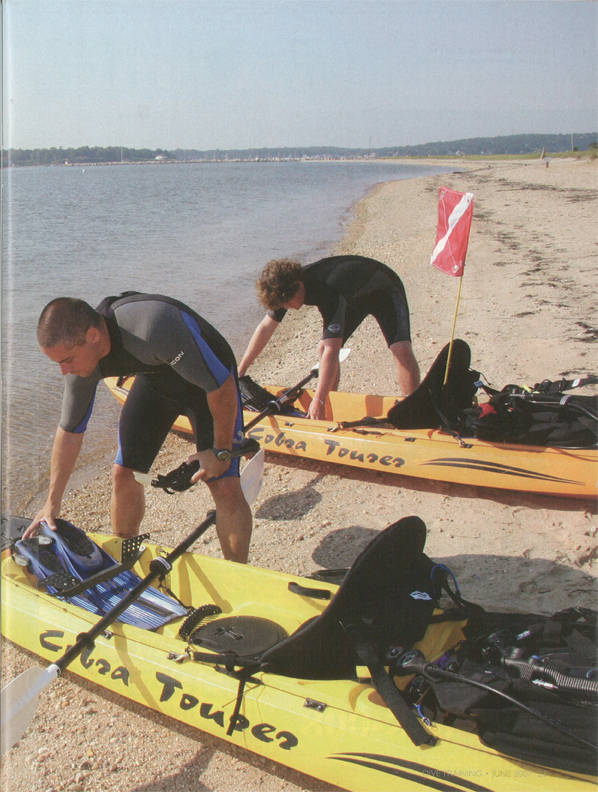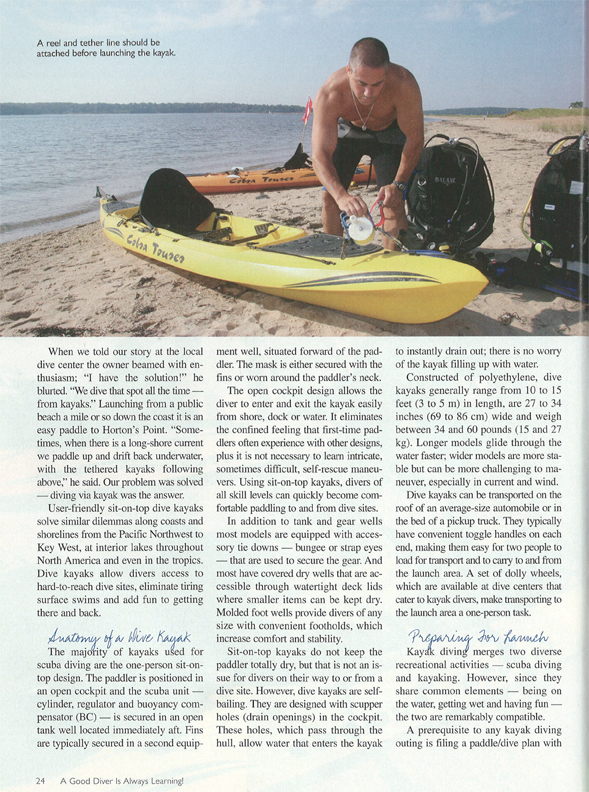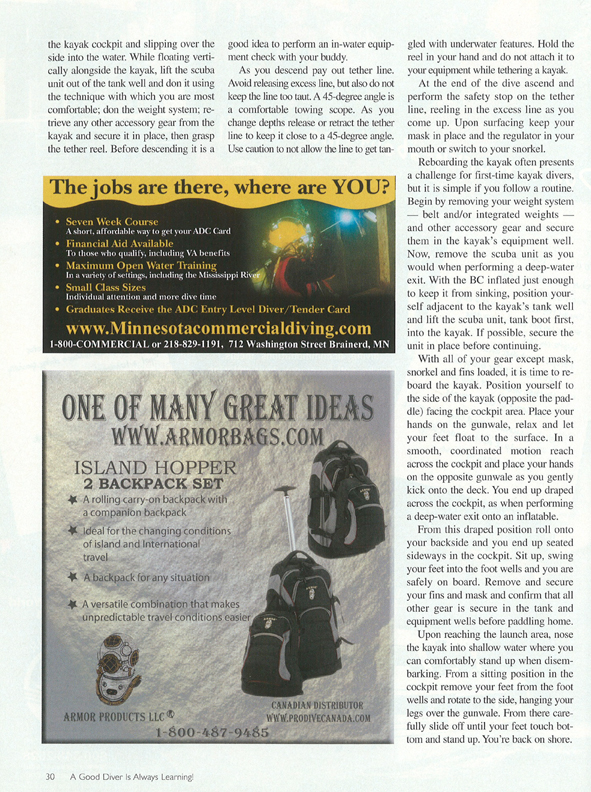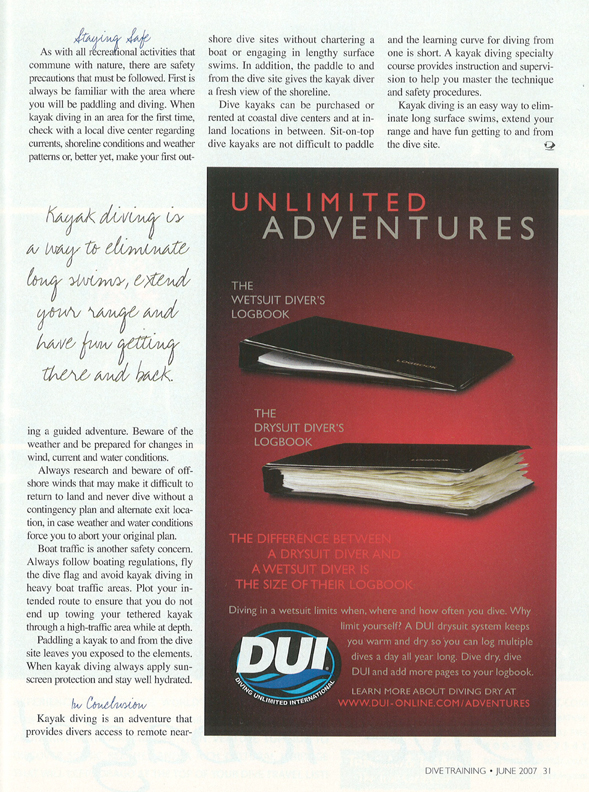Holding Their Breath, Spear Gun in Hand
The New York Times article by Laurie Nadel | Published: July 31, 2005
STRAPPING a belt holding 30 pounds of lead plates to his wet suit, Chris Miller adjusted his snorkel mask and grabbed a yellow spear gun. Looking at the gray fog that engulfed his boat, he asked, ''Why'd they have to do this to me?''
''Pea soup, baby,'' said Ken Ernst, one of three other crew members on Mr. Miller's 24-foot boat, the 4-Play, on a recent Sunday morning. The fog was so thick that Mr. Miller worried about other boats running over his boat's divers.
Mr. Miller, Mr. Ernst and the two other men on the boat, John Buckheit and Ray Keyes, were among 32 contestants who paid $25 each to enter the fifth annual Mike Olsen Spearfishing Tournament. It is named for an Islip man who died in North Carolina while freediving -- diving without scuba gear and oxygen.
Contestants in the tournament were all trying to land a striped bass longer than 40 inches with a three-foot spear. The winner would take home $150 and a plaque. His name would be inscribed on a larger plaque mounted at Soundview Scuba in Southold, the tournament sponsor.
In 2004, Mr. Miller, a marina owner from Montauk, won with a 55-inch fish, and he was determined to take first place again.
After Mr. Miller jumped in, Mr. Buckheit joined him, bobbing in the water. At the helm, Mr. Ernst checked the radar. When he determined that the divers' position was directly above a school of striped bass, he shouted, ''Now!''
Mr. Miller and Mr. Buckheit dived straight down, kicking their rubber flippers. About 90 seconds later, Mr. Buckheit resurfaced. Mr. Miller returned 30 seconds after him. Both men swam back to the boat and climbed aboard. Neither had speared a fish, although they had seen many that were too small for the tournament.
The Mike Olsen tournament is an indicator that spearfishing while freediving is a growing sport on the Island. In 2001, 20 freedivers, all men, signed up for the first tournament on Long Island. Last year, 28 men entered.
Rich Buonaiuto, who organizes the tournament, attributed the sport's growth to several factors. ''It's not expensive,'' he said. ''The fish come closer than when you're making bubbles. You get to see fish in their natural environment. They can hear your heart.''
For centuries, freediving fishermen have speared their families' suppers. Now, only two fishermen on Long Island, both licensed professional divers, use spears, and then for only a small percentage of their annual catch.
But as an extreme sport, freediving combined with spearfishing is growing. In California, ''blue water hunting'' is the term used for spearfishing marlin, tuna and other large fish. ''There is more and more interest in freediving among scuba divers,'' said Steve Burke, the president of the Long Island Divers Association, a group based in East Northport that lobbies for divers' rights around the Island.
Year-round warm, clear water makes freediving and spearfishing especially popular in North Carolina, the Florida Keys and California. Conditions on Long Island, where year-round water temperatures are cold and the water is murky, are challenging, to say the least. ''All you can see is darkness at first,'' Mr. Miller said. ''You're swimming into a void.''
After navigating through layers of plankton to a depth of 40 feet, Mr. Miller, 36, and his crew reported that they could see fish as far as 10 feet away.
''You can't see the bottom and you can't see up,'' said Lance Snead, 41, a scientist from Bellport who entered the tournament. ''You didn't know you could push yourself further. Then it's like a plane breaking through the clouds.''
At 40 feet below, the water becomes clearer, divers say. ''You lie there and the fish thinks, 'Ooh, can I eat that?''' said Mr. Buckheit, 43, a New York City firefighter who lives in Bayport. ''When the fish comes in for a closer look, you shoot him. You only get one shot.''
The dangers and challenges of the sport can be addictive for the weekend amateur.
''You get an adrenaline rush when you see a large fish down there,'' said Mr. Ernst, 43, a software engineer who lives in Blue Point. ''At one point, I had about 20 swim in a circle around me.''
Diving, lying still on the ocean floor, shooting a fish and swimming to the surface while reeling it in has to occur before the diver runs out of air. For most divers, that is one to two minutes. Divers' training regimens to build lung stamina include breathing exercises similar to those in yoga.
''You have to clear your mind of everything, hold your breath and slow down your heart,'' Mr. Miller said.
Mr. Burke of the Long Island Divers Association said interest in freediving was increasing among scuba divers. ''An important reason is a general interest in water sports,'' he said. ''Plus you have to be in reasonably good shape.''
Lou Cersosim, the president of Empire State Freedivers, a chapter of the Underwater Society of America, says it takes a different mind-set to tackle freediving. ''You have to be a little nuts,'' said Mr. Cersosim, 62, a retired Long Island Rail Road engineer who lives in North Babylon and who had entered the tournament. ''It's not for the meek.''
In the tournament, it was 3:30 p.m. when Mr. Miller brought back a 49-inch striped bass caught off Plum Island.
''He looked like he was pretty hefty,'' Mr. Miller said. ''I had him right where I wanted him, on this fin. He shot off across the top of this boulder, scraping my line.''
Concerned that the striper would break his line, Mr. Miller followed it across the boulder before heading to the surface. ''I was trying to keep him from pulling me back to the bottom,'' he said. He estimated that he held his breath underwater for two minutes.
Mr. Miller took his family and crew to Southold, where the other contestants gathered for the weigh-in at Soundview Scuba. His striper weighed 49 pounds, one pound per inch, an easy winner over a 47-inch 45.1-pounder speared by Mr. Snead.
With his 3-year old daughter, Emily, on his shoulders, Mr. Miller said: ''He was a tough fish. He made me work hard.''
Photo: Chris Miller, above, won the fifth annual Mike Olsen Spearfishing Tournament with a 49-inch striped bass that weighed 49 pounds. (Photo by Deirdre Brennan for The New York Times)
Path to Sidewalk Repair Clear
The Independent article by Kitty Merril | Published: August 6, 2005
Water Sports: Part I
The Traveler Watchman article by Marie Fossa | Published: July 1997
Kayak Diving
Dive Training article by Lynn Laymon | Published: June 2007
ACCOMPLISHMENT
Newsday article by Caryn Eve Murray | Published: August 7, 2004
Poised at the water's edge on the rocky coast of the Long Island Sound, Richard Buonaiuto and eight teens with diabetes took the plunge together.
The kids, who arrived there late last month as winners of an essay contest, came to train and get certified for their ultimate prize - an all-expense-paid adventure scuba vacation in the Virgin Islands, through Aug. 1. That's where Buonaiuto, of Soundview Scuba in Southold, came into the picture: He was among those seeing that they trained safely and properly for an extreme sport that, for persons with diabetes, can be especially risky. And, in a way, even for this veteran instructor, this was new water, too. "I have never instructed eight children all with Type 1 diabetes," said Buonaiuto, 32, of Miller Place. "So it was definitely different." There was, for one thing, rigorous testing of blood-sugar levels before any dive, and between the medical staff that accompanied the kids, and the instructors from Soundview, instruction was undertaken on a 1-to-1 ratio. But it was doable, and that was the point of the Ascensia Dream Fund contest, sponsored by Bayer Diagnostics: to engage diabetic kids in more than just wishful thinking.
In short, to dive right in.
"Many people with diabetes are told, in general, that they can never fly a plane, never join the military and never scuba dive. But we are working with some doctors and other people around the country to make this happen," said Colleen McCarthy LaPierre, 36, who won the first-ever grant from the fund earlier this year. LaPierre, diagnosed with diabetes at age 13, recently became a certified scuba diver and soon after developed this program. The Rhode Island resident, director of programs for the Barton Center for Diabetes Education in Massachusetts, learned from her friend Pat Pierson at Cornell Cooperative Extension in Yaphank that Soundview Scuba was available to do the training. Camp Quinipet on nearby Shelter Island offered a convenient and roomy enough site for classroom training, nearby pool work and overnight accommodations for the 16- and 17-year-olds, who came from around the country to prepare for the adventure.
"You have to start charting your blood-sugar trends early, and an hour before the time we dive, we do a pre-dive check, an hour before, a half-hour before, and 10-minutes before," she said. The danger, LaPierre explained, is that hypoglycemia - too low a blood sugar - can lead to passing out. So crackers and other snacks were present along with the traditional scuba gear."The kids were fantastic, very eager, very enthusiastic," said Buonaiuto, whose own scuba adventures have taken him to the South Pacific and the south Caribbean. "I am sure a lot of kids think about it; if their parents or doctor says, 'You are not going to scuba dive,' they probably won't pursue it," he said. "But now kids can say, 'These kids did it, why can't I?'"

